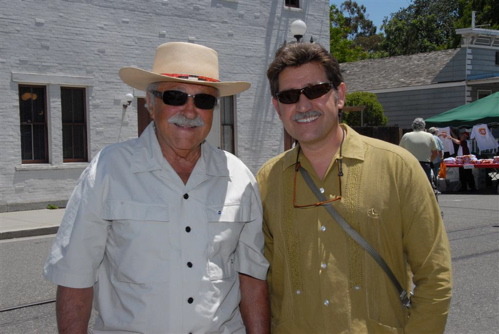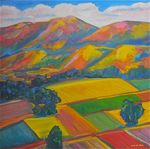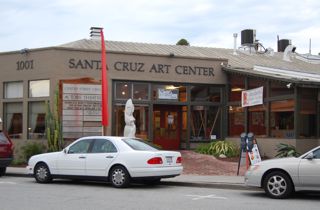 Nathan Oliveira (1928-2010)
Nathan Oliveira (1928-2010)
"My dear friend Nathan Oliveira died at home saturday evening the 13th at 81, I'm already missing our evening conversations"- Joao de brito
November 16, 2010, 11:21 am
Nathan Oliveira died Saturday at Stanford, California. Oliveira, a great artist of Portuguese-American descent, taught at Stanford for three decades. He was part of a group referred to as the Bay Area Figurative Movement, a group of San Francisco area artists in the 1950s and `60s which influenced artists across the country.
I last saw him earlier this year. He gave a lecture at San Jose State University. There was electricity in the air as students gathered for the lecture. The lecture hall filled to standing room only.
No, the lecture wasn't dynamic. It was intimate and personal. It was as if Oliveira sensed all the insecurities young artists can have, and so was gentle with them but without neglecting to inform them they were entering a tough and competitive world. Oliveira was generally soft spoken, though he could be fiery.
Nancy and I met him a few years ago at an opening in Capitola, California. Oliveira might have sensed we didn't know anyone there, so he spoke to us first. After we got comfortable, which was very easy with him, he pointed to a man across the room.
``Do you see that man? After my wife Mona died, I stopped painting. That man kept knocking on my door and said, `You must not stop. You must paint again.'
``I was very angry with him for a time and I wanted him to go away. But you see, I am back, painting again, and so he was right. He has become my very good friend.''
That man was Joao de Brito, also a Portuguese-American artist. Oliveira, de Brito, Mel Ramos and John Mattos are the four artists in the book ``Ashes to Life: A Portuguese American Story in Art,'' which was published in English and Portuguese, English on one side of a page, Portuguese on the other. It strikes me as a good idea, especially when a book straddles two cultures or countries.
I wrote the forward (or Prefacio) for the book and in so doing learned something of Portuguese history, including the fact that the earliest non-native artists in California included the Portuguese. Most historians were aware of the early Spanish and French artists, but in a way the Portuguese had been overlooked.
The four artists in the book, led by Oliveira, have made sure that hasn't happened in the contemporary California art world. Oliveira is internationally known for his paintings of haunting figures, usually alone, often women, set in simple and abstract landscapes of the mind. He was also fascinated by kestrels, and climbed the hills above Stanford searching for falcons and hawks to be abstracted in his paintings.
But he was also a sculptor and printmaker, and until just a few months ago was working on sculpture pieces at the Art Foundry in Sacramento.
``He was a pioneer in the flat art, the print world,'' says Sacramento artist Gregory Kondos. ``He led the parade. To his students he emphasized don't be negative about things associated with you, be positive, work from your heritage.''
Oliveira, who was born in 1928 of Portuguese immigrants, won a Guggenheim Fellowship in 1958 when still a young man, was awarded an NEA artist's grant in 1974 and taught at Stanford from 1964 through 1996.
Of his many awards, he may have been proudest of the Distinguished Degree of Commander in ``The Order of the Infante D. Henrique,'' presented by the president of Portugal and the Portuguese government, because it was only in recent years that being Portuguese-American began to figure importanly in how he looked at his art and himself.
In part that was due to de Brito. In ``Ashes to Life,'' Oliveira told former Smithsonian writer Paul Karlstrom that de Brito ``brought a greater awareness of being Portuguese-American into my life.''
To those who appreciated his art, Oliveira brought a greater awareness and richness of the life around us.
A look at Oliveira and his work from Stanford Magazine:
ttp://www.stanfordalumni.org/news/magazine/2002/novdec/features/oliveira.html
 Friday, June 10, 2011 at 6:45PM
Friday, June 10, 2011 at 6:45PM



